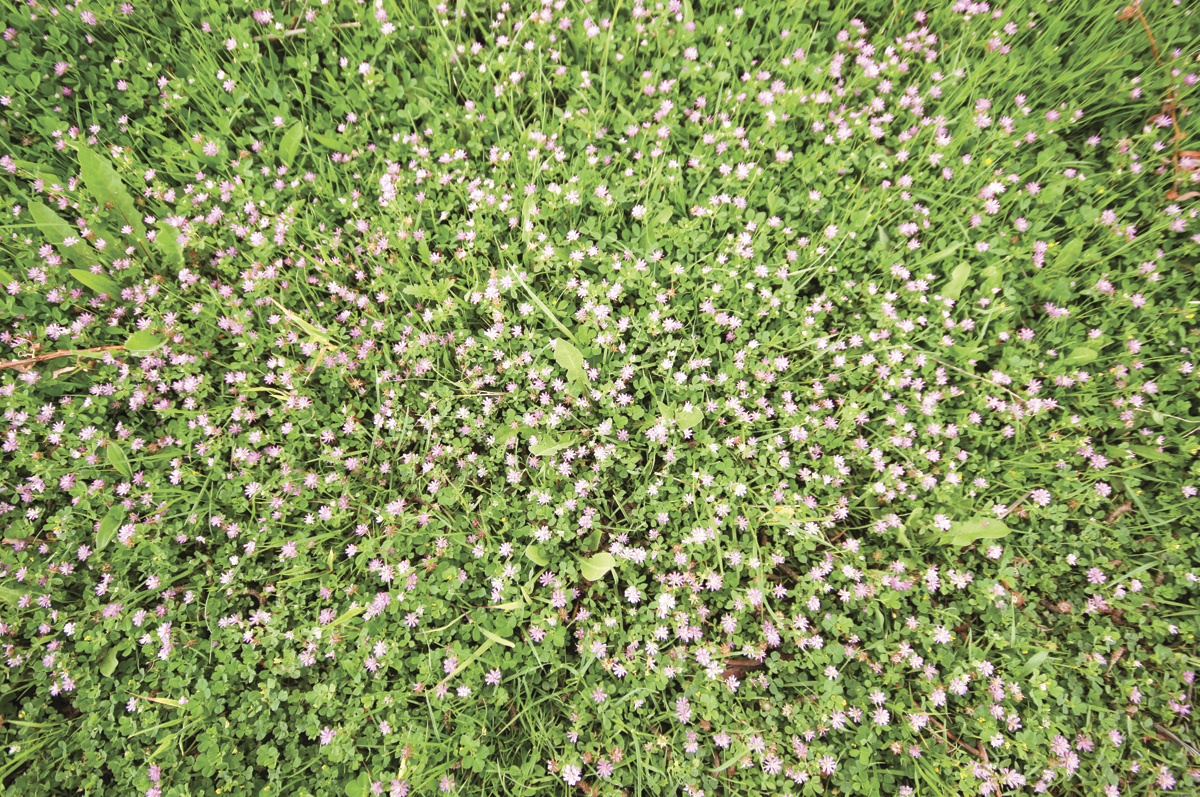Annual clovers that can be planted in the fall and grazed during the winter and spring months are popular additions to many livestock programs in the Southeast region of the U.S. Some advantages to using these clovers include improved grazing distribution, increased forage yield, increased forage quality and reduced nitrogen fertilizer costs. While there are about eight to 10 different species of annual clovers that are adapted to the Southeast region, some of them are adapted to well-drained soil types and others are more adapted to poorly drained sites. The focus of this article will be on annual clover species that are adapted and perform well on poorly drained soil types.
One clover species that is adapted to poorly drained soils is berseem clover (Trifolium alexandrinum). It is an annual, cool-season clover whose origin is unclear. Some believe it originated in Syria, while others consider it to be a native of Egypt. It is even called “Egyptian clover” by some people. Regardless of its origin, it was first grown in the U.S. in California and Texas in the early 1900s. The varieties available at that time lacked freezing tolerance and could not be grown in areas where freezes were common during the growing season. In 1984, the variety Bigbee was released, and it contained enough winter hardiness to be adapted to many states in the southeastern U.S. In 2015, the variety Frosty was released. This variety has more winter hardiness than Bigbee and moved the region of adaptation for berseem clover farther north.
A major advantage of berseem clover is that it is classified as a “non-bloating” legume, and incidences of bloat are lower with berseem clover as compared to most other clover species. In the Southeast, berseem clover can be planted from September through October at a rate of 15 to 20 pounds of pure live seed per acre. Berseem clover has excellent fall growth when planted early and produces more fall and winter growth than most other annual clovers. Its spring flush of growth comes early and lasts until May or early June, giving it a long growing season. Berseem clover has a more upright growth habit compared to most clover species. For this reason, it is probably best to use a rotational system of grazing rather than a continuous system. Some producers in south Louisiana have also grown berseem clover in a mixture with annual ryegrass, and then harvest the crop as baleage in about mid-April. This baleage has produced crude protein (CP) values above 20% and total digestible nutrient values in the mid-60s.
Research studies conducted in south Louisiana on poorly drained soils have shown that berseem clover has consistently provided higher forage yields than other annual clovers. In one trial in Baton Rouge, Louisiana, berseem produced a four-cut total yield of 5,360 pounds per acre compared with yields of 3,935 and 3,720 pounds per acre for ball and Persian clovers, respectively. One disadvantage of berseem clover is that it has low reseeding ability.
Another annual clover species that is adapted to poorly drained soils in the Southeast region is Persian clover (Trifolium resupinatum). It is a native of southern Asia Minor and is a valuable forage crop in Persia and Egypt. In the Southeast region, Persian clover can be planted in September through October at a rate of 5 to 8 pounds of pure live seed per acre. The seed germinates in the fall, and the plant grows throughout the winter in the form of a low rosette. In spring, it grows rapidly and develops many slender, upright flower stems. It produces seed in late spring and then dies. Persian clover produces a large amount of seed and is a very good reseeding species. Most of the forage production from this species occurs from late March to early May.

Persian clover is still considered to be a valuable component of winter pastures along the Gulf Coast that are poorly drained. Getty Images.
There are very few varieties of Persian clover available in the Southeast. The variety Abon was released in the early 1960s by Texas A&M University. It was selected for hard seed production and higher forage yields than “common” Persian clover. In most variety trials conducted in Louisiana over the years, Persian clover normally ranked among the lowest in terms of dry matter forage production as compared to other clover species. However, Persian clover is still considered to be a valuable component of winter pastures along the Gulf Coast that are poorly drained.
The palatability of Persian clover is very high, and also it contains high CP and total digestible nutrient values. Since it has a relatively short growing season, it is utilized primarily as a grazing crop. One of the major concerns among livestock producers who use Persian clover is its bloat potential. In the early spring, it has very lush growth and, consequently, the bloat potential is high. Producers need to make sure they provide an adequate amount of hay available before turning animals out into a pasture that contains a large amount of Persian clover. Poloxalene bloat blocks can also be used to help minimize bloat issues with livestock.
Another potential choice for growing annual clovers in poorly drained areas is ball clover (Trifolium nigrescens). Ball clover has a white inflorescence and looks similar in appearance to white clover. It is a late-maturing clover and also has very good reseeding characteristics. It can be planted from September through October at a seeding rate of 3 to 5 pounds of pure live seed per acre. It has a prostrate growth habit, and consequently it makes a much better choice for grazing rather than for hay or baleage production. It is considered to be of high palatability and quality, but bloat is an issue when grazed by livestock. The only available varieties of ball clover are Grazer’s Select and Don. Ball clover is a very popular choice among hunters who plant wildlife food plots, mainly because of its palatability and excellent reseeding ability.
In summary, the choices for planting an annual clover species for forage utilization in poorly drained areas in the Southeastern region are somewhat limited to berseem, Persian or ball clovers. Each one of these clovers has its advantages and disadvantages. Livestock producers need to evaluate such factors as seed cost and availability, forage production, reseeding ability, level of winter hardiness and bloat potential of these clover species before making their decision on which species to plant.









